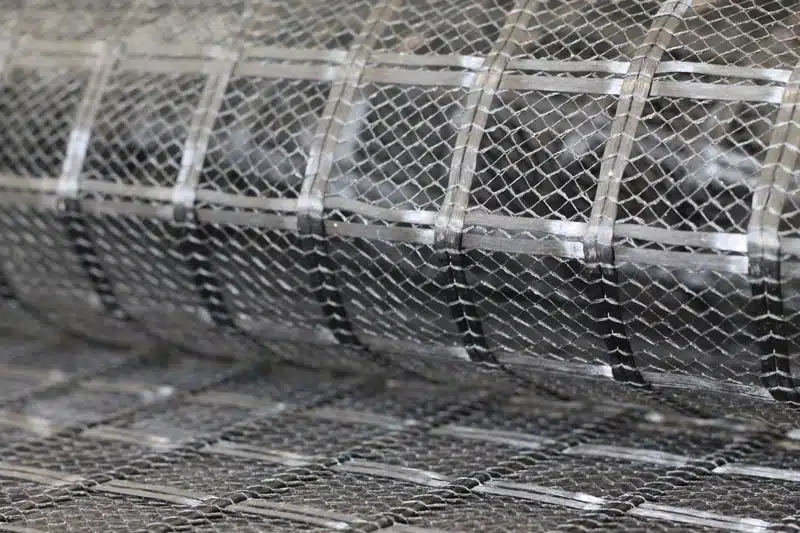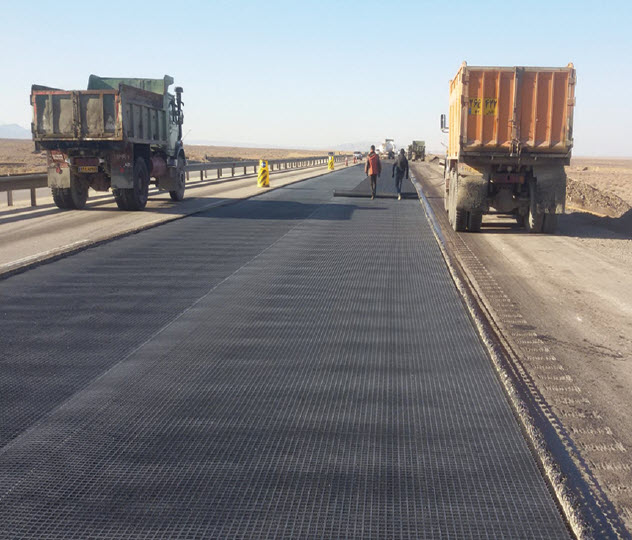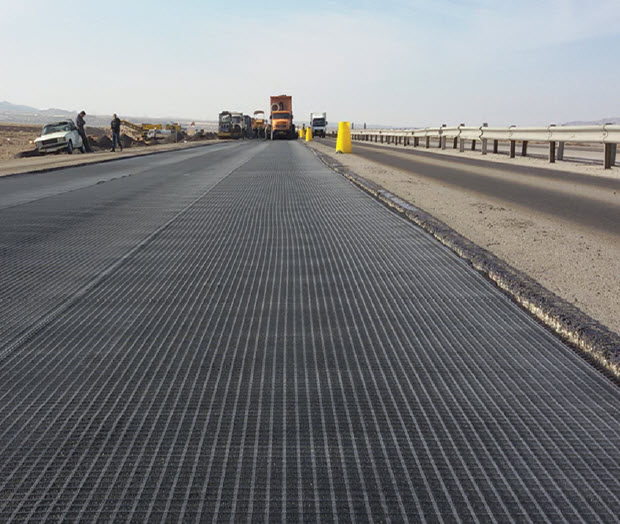GPAsphalt_Geogrid (Asphalt Geogrid)
This kind of Geogrid comprises glass fibers or polyester coated with polymeric-modified asphalt. This product improves the life span of asphalt pavement and delays the reflective cracks that appear on new pavement layers.

Advantages and features of GP Grid Asphalt
- Retarding the growth of reflective cracks in the new asphalt pavement layer (overly)
- Absorbing tensile stress and evenly distributing the tension forces
- Promoting a cohesion force between the existing pavement and new asphalt layers
- Reinforcement of the new asphalt overlay
- Reducing the asphalt overly thickness
- Fast and easy installation without the necessity of specialized workforces.
- Preventing water and moisture penetration into the sub-layers of the pavement
- Reducing asphalt patching area
- It can be used to cover the longitudinal cracks caused by the widening of the road.
- It can be used to cover the micro-trenches.
- It can be used as the reinforcement layer between the concrete pavement and the new asphalt overlay.
- Reducing operating costs in long-term
Asphalt geogrid operates similarly to soil geogrid so that by transferring loads from asphalt particles to geogrid networks, they limit the displacement of asphaltic materials and prevent the formation of cracking or the transfer of previous cracks to the new coating. In addition to increasing the durability of the coating, the use of geogrid in asphalt reduces the required asphalt layer thickness and thus reduces the costs and construction time.

Geo Parsian Co.’s asphalt geogrid is made of woven glass fibers coated with PVC, which are offered in different tensile strengths, such as 20/20, 50/50, and 100/100 kN/m.
Asphalt geogrid layers can be placed on the surface of the old pavement or between the layers of Binder and Topeka.
Characteristics
The two main characteristics of these products are high strength and insignificant elongation. These two features lead to desirable performance of geogrid between asphalt layers. Moreover, the unit weight of a square meter of asphalt geogrid is rather low, which makes it easy for transportation and construction.
The asphalt reinforcement material, comprising glass fibers with a PVC coating, is highly resistant to corrosion, guaranteeing its long durability. Also, its chemical, physical, and thermal properties confirm very high resistance to environmental and atmospheric factors.
Applications
Asphalt pavement geogrids are widely used in pavement and road improvement.
During road improvement process cost reductions are induced by eliminating not only the stage of removing old asphalt pavement, but also the stage of disposing the asphalt pavement waste. It will also reduce the project’s environmental impacts, and the project will be finished substantially faster.
Increasing the speed of implementation of road improvements on roads which are under heavy traffic will have a significant impact on preventing the wastage of national resources.
Gp Grid Asphalt implementation



This woven web of glass fibers delays the transfer of reflective cracks to the top surface of the asphalt for two to three times. This product’s performance is that by converting the stress direction of the reflective crack from vertical to horizontal, it substantially extends the asphalt’s life and thus preserves the asphalt quality over a much longer period. Better asphalt quality reduces the track maintenance time, significantly reducing the cost of ongoing repairs (sometimes exceeding the project’s initial cost).
Another mechanism observed in the asphalt reinforcement layers is the considerable horizontal force tolerance applied to the pavement as the vehicle speed changes. For example, when a car brakes, the severe horizontal force is transmitted from the wheels to the asphalt, which can slow or stop the car. This horizontal force is created by the contact of the wheels with the asphalt, which means it affects a small surface. If the asphalt layer uses an asphalt reinforcement, this element will transfer the brake force to a larger section of the asphalt surface, reducing stress and improving pavement performance.
Also, when the asphalt pavement is exposed to fatigue cracks, expansion cracks due to heat buildup, or shrinkage cracks caused by heat loss, the reinforcements prevent them.
Each strand of glass fibers has a high tensile strength and a significant modulus of elasticity, which corresponds to very low strain.
Studies on this product and its implementation experience at national and international levels have shown its perfect performance in different climatic and geographic conditions, from desert roads to pathways near very cold polar regions, which undergo noticeable atmospheric changes.
In-depth research has been conducted on the factors affecting the performance of asphalt reinforcements in universities and research centres worldwide. Researchers have focused on factors such as the location of the reinforcing elements, the number of layers, the methods of implementation, and the performance of the various types of reinforcements.
But in order to choose the best type of reinforcement for the asphalt in question, the applicability of the product must first be precisely determined. Asphalt geogrids’ most important use cases include roads, airports, bridges, narrow-scale road improvements, and maintenance holes for underground structures. In the meantime, roads are classified as other sub-categories, including highways and roads with less or more than 1% heavy traffic. It is also important in airport subbase reinforcement projects to consider airport traffic types, including international or domestic flights. The difference reflects the aircraft’s dimensions and, as a result, the burden on the subbase. Finally, according to the establishment of each case, the project designer applies the associated parameters to optimize the product design.
Implementation steps
The steps for implementing asphalt geogrids are as follows:
- preparation of the desired pavement surface
- surface geometric correction if needed
- Sealing cracks with openings greater than 4 mm with suitable bitumen material
- Removing any earthy material from the surface
- Implementation of a bitumen layer as an adhesive element between reinforcement and asphalt (The amount and type of bitumen depend on factors such as weather conditions, substrate conditions, and the hardness of the final asphalt layer).
- Execution of the reinforcement
- First, the plastic cover of the Geoparsian company’s asphalt geogrid must be removed. This plastic cover effectively reduces damage during transport and storage. A special roller unit attached to the road-building machines can be used to place the product on the surface, both manually and mechanically.
- No need for nails or any mechanical attachment of reinforcement to the asphalt.
- Implementation of the final layer
- Apply the final asphalt layer on the reinforcement according to the thickness of the pavement design.

